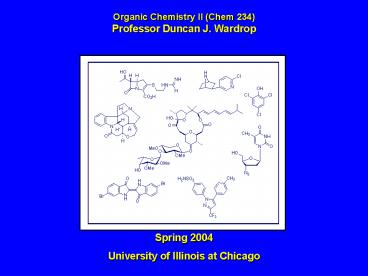Organic Chemistry Fifth Edition
1 / 54
Title:
Organic Chemistry Fifth Edition
Description:
Electrophilic Alkenes. Termite Self-Defense! 18.12. Conjugate Addition to ... Robinson Annelation - The Big Picture. 18.14. Conjugate Addition of Organocopper Reagents ... –
Number of Views:74
Avg rating:3.0/5.0
Title: Organic Chemistry Fifth Edition
1
Organic Chemistry II (Chem 234)Professor Duncan
J. Wardrop
Spring 2004
University of Illinois at Chicago
2
18.9The Aldol Condensation
3
Aldol Condensation
4
Aldol Condensation of Butanal
5
Dehydration of Aldol Addition Product
- dehydration of ?-hydroxy aldehyde can
becatalyzed by either acids or bases
6
Dehydration of Aldol Addition Product
NaOH
- in base, the enolate is formed
7
Dehydration of Aldol Addition Product
NaOH
- the enolate loses hydroxide to form the
?,?-unsaturated aldehyde
8
Aldol reactions of ketones
- the equilibrium constant for aldol addition
reactions of ketones is usually unfavorable
9
Intramolecular Aldol Outpaces Intermolecular
Process
even ketones give good yields of aldol
condensation products when the process is
intramolecular
10
Conformational Picture
11
18.10Mixed Aldol Condensationsa.k.a.Crossed-Con
densations a.k.a.Claisen Schmidt Reaction
12
Mixed Aldol Reactions - A Complex Situation!
- There are four possible aldol products because
the reaction mixture contains the two aldehydes
plus the enolate of each aldehyde.
13
What Nucleophiles and Electrophiles are Present?
Electrophiles
Nuleophiles
14
All Combinations of Enolates and Aldehydes
15
Keys to Successful Crossed Aldol Reactions
In order to carry out practically useful crossed
aldol reactions, the following rules must be
observed 1. Only one of the two carbonyl
components can undergo enolization - one
enolate will be present during reaction 2.
Second carbonyl compound must not undergo
enolization and be more electrophilic than the
enolizable compound - prevents self-condensation
of enolizable carbonyl compound since any enolate
is immediately trapped by the electrophilic
carbonyl compound
16
Formaldehyde No Alpha Protons - No Enolization!
Formaldehyde has no a-protons and therefore
cannot form an enolate Formaldehyde is
extremely reactive toward nucleophilic addition -
consider the size of Khydration
17
Crossed Aldol Reaction with Formaldehyde
18
Aldehydes Which Do Not Have Alpha Protons
- These aldehydes cannot form enolates
19
Crossed Aldol Reaction with Aromatic Aldehydes
One possible enolate anion. Self condensation is
slower than reaction with aromatic aldehyde
Electrophilic and unable to enolize
Dehydration is favorable because of conjugated
nature of product
20
18.11Effects of Conjugation in ???-Unsaturated
Aldehydes and Ketones
21
Nucleophilic (and not so nucleophilic) Alkenes
22
Relative Stability of Unsaturated Carbonyl
Compounds
- aldehydes and ketones that contain a
carbon-carbon double bond are more stable when
the double bond is conjugated with the carbonyl
group than when it is not - compounds of this type are referred to as ?,?
unsaturated aldehydes and ketones
23
Relative Stability of a,b and g,d-Carbonyl
Compounds
24
Acrolein - An Orbital Picture
25
Acrolein - An Orbital Picture
26
Acrolein - An Orbital Picture
27
Acrolein - An Orbital Picture
28
Acrolein - A Resonance Description
29
a,b-Carbonyl Compounds are Ambient Electrophiles
- ???-Unsaturated aldehydes and ketones are more
polar than simple aldehydes and ketones. - ???-Unsaturated aldehydes and ketones contain
two possible sites for nucleophiles to attack - carbonyl carbon
- ?-carbon
30
A Comparison of Dipole Moments
?
?
?
?
?
Butanal
trans-2-Butenal
- greater separation of positive and negative
charge
31
Electrophilic Alkenes
32
Termite Self-Defense!
33
18.12Conjugate Addition to ???-Unsaturated
Carbonyl Compounds
34
Nucleophilic Addition to a,b-Unsaturated Carbonyl
Compounds
- 1,2-addition (direct addition)
- nucleophile attacks carbon of CO
- 1,4-addition (conjugate addition)
- nucleophile attacks ?-carbon
35
- attack is faster at CO
- attack at ?-carbon gives the more stable product
36
1,2-addition
- formed faster
- major product under conditions of kinetic
control (i.e. when addition is not readily
reversible)
37
1,4-addition
- enol
- goes to keto form under reaction conditions
38
1,4-addition
- keto form is isolated product of 1,4-addition
- is more stable than 1,2-addition product
39
1,2-addition
1,4-addition
CO is stronger than CC
40
1,2-Addition to a,b-Unsaturated Carbonyl Compounds
- observed with strongly basic nucleophiles
- Grignard reagents
- LiAlH4
- NaBH4
- Sodium acetylide
- strongly basic nucleophiles add irreversibly
41
Acetylenic Grignard Reagents Undergo 1,2-Addition
42
1,4-Addition to a,b-Unsaturated Carbonyl Compounds
- observed with weakly basic nucleophiles
- cyanide ion (CN)
- thiolate ions (RS)
- ammonia and amines
- azide ion (N3)
- weakly basic nucleophiles undergo
- reversible addition
43
Example
(93-96)
44
Example
O
C6H5CH2SH
HO, H2O
(58)
45
18.13Addition of Carbanions to???-Unsaturated
Carbonyl CompoundsThe Michael Reaction
46
1,4-Addition of Enolates to a,b-Unsaturated Carbon
yl Compounds - The Michael Reaction
- Stabilized carbanions, such as those derived
from ?-diketones undergo conjugateaddition to
?,?-unsaturated ketones.
47
The Michael Reaction - An Example
48
Michael Addition is a Useful Process!
- The Michael reaction is a useful method
forforming carbon-carbon bonds. - It is also useful in that the product of the
reaction can undergo an intramolecularaldol
condensation to form a six-membered ring. One
such application is called the Robinsonannelation
.
49
Robinson Annelation - A Type of Michael Addition
50
Robinson Annelation - The Big Picture
51
18.14Conjugate Addition of Organocopper
Reagentsto ???-Unsaturated Carbonyl Compounds
52
Addition of Organocopper Reagents
to???-Unsaturated Aldehydes and Ketones
- The main use of organocopper reagents is toform
carbon-carbon bonds by conjugate addition to
?,?-unsaturated ketones.
53
Addition of Organocopper Reagents
to???-Unsaturated Aldehydes and Ketones
54
Information Suggested Problems
Suggested Problems 18.39-18.42
-------------------------------------------------
---------------- Office Hour Thursday, 3.30
P.M., SES 4446 -----------------------------------
------------------------------






























